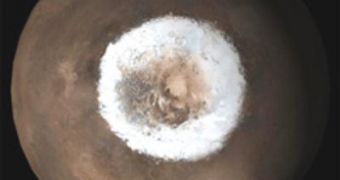Mars has two permanent polar ice caps, the largest one being at the South Pole, much like those found at the poles on Earth. However, liquid water does not exist on the surface, but large quantities of water are thought to be trapped underneath Mars' thick cryosphere, only to be released when the crust is cracked through volcanic action.
This year NASA announced that if the ice at Mars' South Pole were to melt, it would form an 11 meters-deep (36 ft) ocean that would cover the entire surface of the planet. Now, recent observations made by ESA's Mars Express mission and climate models of the Red Planet, allowed the scientists to propose a theory about the origins of this ice cap.
It seems that the Sun is in fact responsible for the formation of the thick ice crust, as Mars' orbit affects the deposition of water at the South Pole. Previously undetected perennial deposits of water-ice have recently been found sitting on top of a layered space on the surface which formed one million years ago, proving that there has been recent glacial activity on Mars' South Pole.
The latest mapping and spectral analysis show that this perennial ice deposits are made up of three types of ice, one made of water mixed with carbon dioxide, one covered by a thin layer of carbonic ice and wide patches of water-ice tens of kilometers wide.
Franck Montmessin, from the Service d'A?ronomie du CNRS/IPSL (France) and lead author of the findings, proposed an explanation for the formation of the two types of ice, not covered in CO2: "We believe that the deposits of water-ice are juggled between Mars' North and South Poles over a cycle that spans 51 000 years, corresponding to the time span in which the planet's precession is inverted."
The precession phenomenon is a change in the direction of the axis of a rotating, making this axis describe a cone, with the sound tip fixed and the north one moving in a circle. So, it looks like water from the North Pole of the planet was transported to the South Pole due to its instability and this precession movement, depositing around 1 millimeter of ice at the south each year.
Since 10,000 years ago the precession was inverted, ice from the South Pole is currently migrating back towards the North Pole, which causes the formation of the newly discovered layers of ice, not covered in carbon dioxide or mixed with it.

 14 DAY TRIAL //
14 DAY TRIAL //